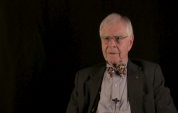7:17 | Burt Vardeman was at his waist gun when one of the fighter escorts flew close enough to see the pilot's face. Was that a black pilot? He really got an eye opening experience when his plane developed engine trouble and had to crash land at what turned out to be the base of the Tuskegee Airmen.
Keywords : Burt Vardeman radio operator Consolidated B-24 Liberator Tuskegee Airmen bail out crash landing tail gunner Leo Hartman

Drafted out of high school in 1943, Burt Vardeman went to basic with the Army Air Corps. He scored high on radio aptitude and trained as a radio operator on a B-24 crew. Flying out of Italy, he had a close call when one engine after another failed on the return flight. The order came from the pilot, prepare to bail out!
On his first mission, B-24 radio operator Burt Vardeman saw a plane explode after a direct hit from a flak shell. No parachutes. It was a real quick lesson in how deadly this game was.
After several missions, the crew began to settle down and get used to the routine. On mission days it was a series of preparations and briefings, and then into the B-24's. Radio operator Burt Vardeman recalls the progression right through to the end with the shot of whiskey.
The B-24 air base was near Foggia in Italy but the base for their fighter escorts was much closer to the front. Radio operator Burt Vardeman describes how they would rendezvous and proceed to the target. It was late in the war and the threat from German fighters was diminishing.
The pilots hated it and so did all the crews. If a mission was scrubbed, they were supposed to land with their bomb load intact. The policy was sometimes different but Burt Vardeman went through a nerve wracking experience when his plane came in with a full load and the nose wheel gave way.
B-24 radio operator Burt Vardeman fondly remembers the Italian locals who lived in the village near his air base. They were kind and helpful and, after the war, his squadron returned the favor.
Burt Vardeman was a B-24 crewman who had a great deal of respect for the soldiers and sailors he felt had a rougher time than he did. He expected to go to the Pacific after VE Day but he got some good news while recuperating in Miami.
Where was this Pearl Harbor? Burt Vardeman was still in high school when the sneak attack occurred and when he graduated in 1943, he became one of the many draftees called up for the fight.
An aptitude for radio put draftee Burt Vardeman on a track to become a crewman in the Army Air Corps. Once he learned radio he had to learn gunnery and then he became part of a B-24 crew. He was the only Southerner but he learned to get along with the Yankees.
Would it be Europe or the Pacific? When Burt Vardeman's crew was sent to Virginia, they knew it would be Europe. They crossed the Atlantic on a Liberty ship and went ashore in Italy. They would be flying their bombing missions from there.
It happened right in front of him. On his very first mission, B-24 radio operator Burt Vardeman saw a plane up ahead in the formation explode from a direct hit by a flak shell. I'm never going to get home, he thought.
They were nearly all high altitude missions but, occasionally, there would be a low level target. Burt Vardeman recalls a mission targeting the Brenner Pass during which the plane was actually the target of flak fired from above.
Burt Vardeman describes the flak faced by the B-24 crew on nearly every mission. Even without a direct hit the shrapnel could kill a man or bring down a plane, as it did to his bomber.
Everyone hated it, especially the pilot. Sometimes, when a mission was scrubbed, the planes had to return to base with a full bomb load. Burt Vardeman remembers one of these missions which nearly ended in disaster despite an almost perfect landing.
What was it like in a B-24 on a bombing mission? Burt Vardeman discusses the practical aspects of flying such as dealing with the cold and what you have to do to relieve yourself. What about the bad weather and what do you do when you get back to the base?
There was no defense against the flak. When you're on the bomb run, you have to maintain altitude and bearing to have an accurate drop. There can be no evasion until the bombs are away. Burt Vardeman recalls the gastric distress that went on in the latrine before every mission because of the impending danger.
After VE Day, Burt Vardeman returned stateside and was told he would be training for the Pacific after some leave. He got his leave, as well as a stay at a plush Miami hotel to recuperate. When it finally was all over, he and the entire nation returned to their own private lives. They had done it and they had done it all together.